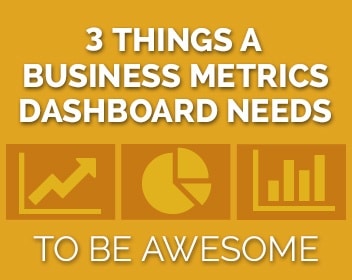2 September 2016
3 Things A Business Metrics Dashboard Needs To Be Awesome
 Do you want your business tools to be second-rate?
Do you want your business tools to be second-rate?
No! You want them to be awesome! You want your company to be using the most streamlined and modern software around, and your dashboards should be no different.
When building your business metrics dashboard, there are nearly an unlimited number of things that it can do.
But the important thing is to focus on what it should do.
Dashboards, especially ones that help you understand your business’ metrics, are all about making sure that information is not just available, but focused. Overwhelm the user with the wrong data or even too much of the right data and it could end up being a mess.
How can you be sure that your dashboard is set up properly when every business has unique needs? How do you take it from “run of the mill” to “awesome”?
If you start with these three things, you’ll be on your way.
1) SMART Goals
You already know that goals are vital when measuring up your business’s data to ensure you’re heading in the right direction, but here’s the thing you may not realize: not all goals are created equal.
S.M.A.R.T. goals are a framework used to build intelligent objectives that allow you to have a clearly focused and accountable target that’s tied to a timeline. We’ve covered it previously regarding marketing your website, and it’s applicable in other areas of your business.
Here’s a terrible goal: “make more money”
Here’s that as a S.M.A.R.T. goal: “15% increase in revenue from existing clients by 2017.”
It’s specific, measurable, attainable, realistic, and timely. If you have this type of goal framework built into your dashboard, imagine how effective it would be!
2) Simplicity
Datasets, timelines, graphs, KPIs, trends, analysis, margins – the sheer amount of information you can track in your business can be immense.

A dashboard is about simplicity. It’s about focusing all of that data so a person can get a quick at-a-glance impression of what’s going on in your business.
The goal here is not to give the user the full volume of information, but just enough to know if it merits their attention.
- Instead of a full range of projects with their timelines, show those that are falling behind
- Revenue can be shown in trends, not just raw numbers
- KPIs can be represented with simple graphs showing their current status compared to your goals.
3) Customization
It’s a simple fact: businesses evolve.
Think about how far your business has come over the years; how your processes have changed to meet your customers’ demands, etc.
When settling in on a metrics dashboard, you’ll need to make sure that it can evolve with you. This means having the customization options in place to not only change the design but data sets and sources as well.
Are you still using the same time tracking program? What about CRM?
What about new departments and divisions? Do your sales people need to see the same data as your accountants?
Being painted into a corner is never fun, especially if what you need is on the other side of the room.
You should have a better idea of where to focus with your business metrics dashboard to take it to the next level. With so much information being streamlined into a single at-a-glance page, it’s important to think things through properly.
If you do, you can end up with something really awesome.






